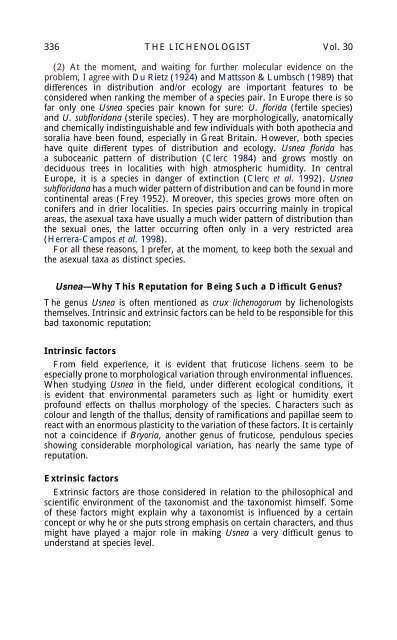SPECIES CONCEPTS IN THE GENUS USNEA (LICHENIZED ...
SPECIES CONCEPTS IN THE GENUS USNEA (LICHENIZED ...
SPECIES CONCEPTS IN THE GENUS USNEA (LICHENIZED ...
Create successful ePaper yourself
Turn your PDF publications into a flip-book with our unique Google optimized e-Paper software.
336 <strong>THE</strong> LICHENOLOGIST Vol. 30<br />
(2) At the moment, and waiting for further molecular evidence on the<br />
problem, I agree with Du Rietz (1924) and Mattsson & Lumbsch (1989) that<br />
differences in distribution and/or ecology are important features to be<br />
considered when ranking the member of a species pair. In Europe there is so<br />
far only one Usnea species pair known for sure: U. florida (fertile species)<br />
and U. subfloridana (sterile species). They are morphologically, anatomically<br />
and chemically indistinguishable and few individuals with both apothecia and<br />
soralia have been found, especially in Great Britain. However, both species<br />
have quite different types of distribution and ecology. Usnea florida has<br />
a suboceanic pattern of distribution (Clerc 1984) and grows mostly on<br />
deciduous trees in localities with high atmospheric humidity. In central<br />
Europe, it is a species in danger of extinction (Clerc et al. 1992). Usnea<br />
subfloridana has a much wider pattern of distribution and can be found in more<br />
continental areas (Frey 1952). Moreover, this species grows more often on<br />
conifers and in drier localities. In species pairs occurring mainly in tropical<br />
areas, the asexual taxa have usually a much wider pattern of distribution than<br />
the sexual ones, the latter occurring often only in a very restricted area<br />
(Herrera-Campos et al. 1998).<br />
For all these reasons, I prefer, at the moment, to keep both the sexual and<br />
the asexual taxa as distinct species.<br />
Usnea—Why This Reputation for Being Such a Difficult Genus?<br />
The genus Usnea is often mentioned as crux lichenogorum by lichenologists<br />
themselves. Intrinsic and extrinsic factors can be held to be responsible for this<br />
bad taxonomic reputation:<br />
Intrinsic factors<br />
From field experience, it is evident that fruticose lichens seem to be<br />
especially prone to morphological variation through environmental influences.<br />
When studying Usnea in the field, under different ecological conditions, it<br />
is evident that environmental parameters such as light or humidity exert<br />
profound effects on thallus morphology of the species. Characters such as<br />
colour and length of the thallus, density of ramifications and papillae seem to<br />
react with an enormous plasticity to the variation of these factors. It is certainly<br />
not a coincidence if Bryoria, another genus of fruticose, pendulous species<br />
showing considerable morphological variation, has nearly the same type of<br />
reputation.<br />
Extrinsic factors<br />
Extrinsic factors are those considered in relation to the philosophical and<br />
scientific environment of the taxonomist and the taxonomist himself. Some<br />
of these factors might explain why a taxonomist is influenced by a certain<br />
concept or why he or she puts strong emphasis on certain characters, and thus<br />
might have played a major role in making Usnea a very difficult genus to<br />
understand at species level.

















